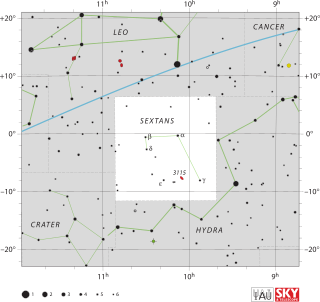
Sextans is a faint, minor equatorial constellation which was introduced in 1687 by Polish astronomer Johannes Hevelius. Its name is Latin for the astronomical sextant, an instrument that Hevelius made frequent use of in his observations.

Messier 83 or M83, also known as the Southern Pinwheel Galaxy and NGC 5236, is a barred spiral galaxy approximately 15 million light-years away in the constellation borders of Hydra and Centaurus. Nicolas-Louis de Lacaille discovered M83 on 23 February 1752 at the Cape of Good Hope. Charles Messier added it to his catalogue of nebulous objects in March 1781.

The Sagittarius Dwarf Spheroidal Galaxy (Sgr dSph), also known as the Sagittarius Dwarf Elliptical Galaxy, is an elliptical loop-shaped satellite galaxy of the Milky Way. It contains four globular clusters in its main body, with the brightest of them—NGC 6715 (M54)—being known well before the discovery of the galaxy itself in 1994. Sgr dSph is roughly 10,000 light-years in diameter, and is currently about 70,000 light-years from Earth, travelling in a polar orbit at a distance of about 50,000 light-years from the core of the Milky Way. In its looping, spiraling path, it has passed through the plane of the Milky Way several times in the past. In 2018 the Gaia project of the European Space Agency showed that Sgr dSph had caused perturbations in a set of stars near the Milky Way's core, causing unexpected rippling movements of the stars triggered when it moved past the Milky Way between 300 and 900 million years ago.

Centaurus A is a galaxy in the constellation of Centaurus. It was discovered in 1826 by Scottish astronomer James Dunlop from his home in Parramatta, in New South Wales, Australia. There is considerable debate in the literature regarding the galaxy's fundamental properties such as its Hubble type and distance. NGC 5128 is one of the closest radio galaxies to Earth, so its active galactic nucleus has been extensively studied by professional astronomers. The galaxy is also the fifth-brightest in the sky, making it an ideal amateur astronomy target. It is only visible from the southern hemisphere and low northern latitudes.
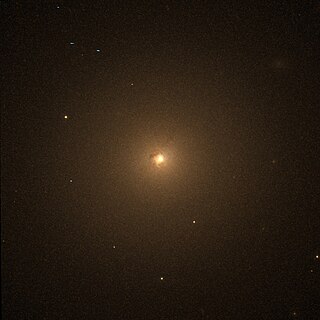
NGC 404 is a field galaxy located about 10 million light years away in the constellation Andromeda. It was discovered by William Herschel in 1784, and is visible through small telescopes. NGC 404 lies just beyond the Local Group and does not appear gravitationally bound to it. It is located within 7 arc-minutes of second magnitude star Mirach, making it a difficult target to observe or photograph and granting it the nickname "Mirach's Ghost".

The Centaurus A/M83 Group is a complex group of galaxies in the constellations Hydra, Centaurus, and Virgo. The group may be roughly divided into two subgroups. The Cen A Subgroup, at a distance of 11.9 Mly, is centered on Centaurus A, a nearby radio galaxy. The M83 Subgroup, at a distance of 14.9 Mly, is centered on the Messier 83 (M83), a face-on spiral galaxy.
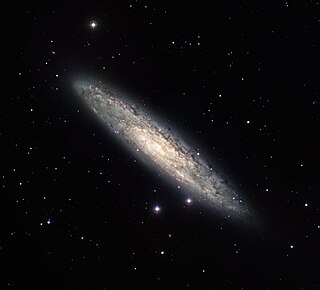
The Sculptor Galaxy is an intermediate spiral galaxy in the constellation Sculptor. The Sculptor Galaxy is a starburst galaxy, which means that it is currently undergoing a period of intense star formation.
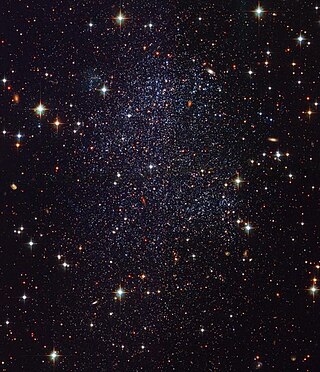
The Sagittarius Dwarf Irregular Galaxy (SagDIG) is a dwarf galaxy in the constellation of Sagittarius. It lies about 3.4 million light-years away. It was discovered by Cesarsky et al. on a photographic plate taken for the ESO (B) Atlas on 13 June 1977 using the ESO 1 meter Schmidt telescope.

NGC 1569 is a dwarf irregular galaxy in Camelopardalis. The galaxy is relatively nearby and consequently, the Hubble Space Telescope can easily resolve the stars within the galaxy. The distance to the galaxy was previously believed to be only 2.4 Mpc. However, in 2008 scientists studying images from Hubble calculated the galaxy's distance at nearly 11 million light-years away, about 4 million light-years farther than previously thought, meaning it is a member of the IC 342 group of galaxies.

IC 1613 is an irregular dwarf galaxy, visible in the constellation Cetus near the star 26 Ceti. It was discovered in 1906 by Max Wolf, and is approaching Earth at 234 km/s.

IC 342 is an intermediate spiral galaxy in the constellation Camelopardalis, located relatively close to the Milky Way. Despite its size and actual brightness, its location behind dusty areas near the galactic equator makes it difficult to observe, leading to the nickname "The Hidden Galaxy", though it can readily be detected even with binoculars. If the galaxy were not obscured, it would be visible by naked eye. The dust makes it difficult to determine its precise distance; modern estimates range from about 7 million light-years (Mly) to about 11 Mly. The galaxy was discovered by William Frederick Denning in 1892. It is one of the brightest in the IC 342/Maffei Group, one of the closest galaxy groups to the Local Group. Edwin Hubble first thought it to be in the Local Group, but it was later determined not to be a member.

NGC 7793 is a flocculent spiral galaxy in the southern constellation of Sculptor. It was discovered in 1826 by Scottish astronomer James Dunlop. The galaxy is located at a distance of 12.2 million light years and is receding with a heliocentric radial velocity of 227 km/s. NGC 7793 is one of the five brightest galaxies within the Sculptor Group.

NGC 5253 is an irregular galaxy in the constellation Centaurus. It was discovered by William Herschel on 15 March 1787.

Sextans B is an irregular galaxy that may be part of the Local Group, or lie just beyond it. Sextans B is 4.44 million light-years away from Earth and thus is one of the most distant members of the Local Group, if it is indeed a member. It forms a pair with its neighbouring galaxy Sextans A. It is a type Ir IV–V galaxy according to the galaxy morphological classification scheme. Sextans B may also be gravitationally associated with the galaxies NGC 3109 and the Antlia Dwarf.

UGCA 86 is a Magellanic spiral galaxy. It was first thought to be part of the Local Group, but after the brightest stars in the galaxy were observed, it became clear that it was located in the IC 342/Maffei Group. UGCA 86 is thought to be a satellite galaxy of IC 342, however the separation between the two galaxies is over 50% larger than the distance between the Milky Way and the Magellanic Clouds.
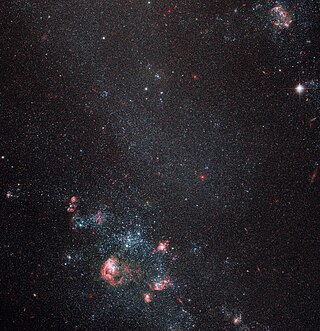
IC 2574, also known as Coddington's Nebula, is a dwarf spiral galaxy discovered by American astronomer Edwin Foster Coddington in 1898. Located in Ursa Major, a constellation in the northern sky, it is an outlying member of the M81 Group. It is believed that 90% of its mass is in the form of dark matter. IC 2574 does not show evidence of interaction with other galaxies. It is currently forming stars; a UV analysis showed clumps of star formation 85 to 500 light-years in size.

NGC 5965 is a spiral galaxy located in the constellation Draco. It is located at a distance of circa 150 million light years from Earth, which, given its apparent dimensions, means that NGC 5965 is about 260,000 light years across. It was discovered by William Herschel on May 5, 1788.
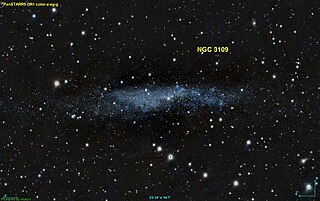
The Antlia-Sextans Group is a small grouping of galaxies in the constellations Hydra, Sextans, Antlia and Leo. It is generally considered to be at the very edge of the Local Group and thus part of it. However, other researchers indicate it is an independent group, and thus the nearest group to the Local Group. It is, on average, approximately 4.3 million light-years away from the Milky Way.


















